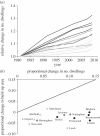Temporal changes in greenspace in a highly urbanized region
- PMID: 21429910
- PMCID: PMC3169039
- DOI: 10.1098/rsbl.2011.0025
Temporal changes in greenspace in a highly urbanized region
Abstract
The majority of the world's population now lives in towns and cities, and urban areas are expanding faster than any other land-use type. In response to this phenomenon, two opposing arguments have emerged: whether cities should 'sprawl' into the wider countryside, or 'densify' through the development of existing urban greenspace. However, these greenspaces are increasingly recognized as being central to the amelioration of urban living conditions, supporting biodiversity conservation and ecosystem service provision. Taking the highly urbanized region of England as a case study, we use data from a variety of sources to investigate the impact of national-level planning policy on temporal patterns in the extent of greenspace in cities. Between 1991 and 2006, greenspace showed a net increase in all but one of 13 cities. However, the majority of this gain occurred prior to 2001, and greenspace has subsequently declined in nine cities. Such a dramatic shift in land use coincides with policy reforms in 2000, which favoured densification. Here, we illustrate the dynamic and policy-responsive nature of urban land use, thereby highlighting the need for a detailed investigation of the trade-offs associated with different mechanisms of urban densification to optimize and secure the diverse benefits associated with greenspaces.
Figures


References
-
- UN. World urbanization prospects: the 2007 revision. New York, NY: United Nations.: 2008.
-
- Antrop M. 2000. Changing patterns in the urbanized countryside of Western Europe. Landsc. Ecol. 15, 257–27010.1023/A:1008151109252 (doi:10.1023/A:1008151109252) - DOI - DOI
-
- CEC 1999. European spatial development perspective: towards a balanced and sustainable development of the territory of the EU. Luxembourg: Office for Official Publications of the European Communities
-
- EEA 2006. Urban sprawl in Europe: the ignored challenge. EEA Report number 10. European Commission Joint Research Centre, Copenhagen, Denmark
-
- Johnson M. P. 2001. Environmental impacts of urban sprawl: a survey of the literature and proposed research agenda. Environ. Plan. A 33, 717–73510.1068/a332 (doi:10.1068/a332) - DOI - DOI
Publication types
MeSH terms
LinkOut - more resources
Full Text Sources

